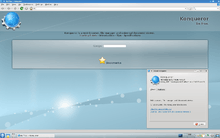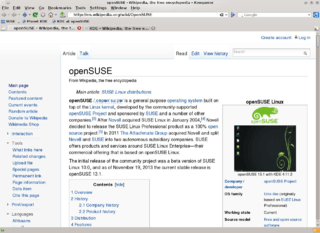Konqueror
 | |
|
Konqueror browser 4.11.5 on openSUSE 13.1 | |
| Developer(s) | KDE |
|---|---|
| Initial release | 14 October 1996[1] |
| Stable release | 4.14.3 (November 11, 2014) [±][2] |
| Written in | C++ (Qt) |
| Operating system | Unix like, Microsoft Windows[3] |
| Engines | WebKit, KHTML |
| Available in | Multilingual |
| Type | Web browser, file browser |
| License | GPLv2+ |
| Website |
konqueror |
Konqueror is a free and open-source web browser and file manager that provides file viewer functionality for file systems such as local files, files on a remote FTP server and files in a disk image. It is a core part of the KDE Software Compilation. Konqueror is developed by volunteers and can run on most Unix-like operating systems and on Windows systems. Konqueror is licensed and distributed under the GNU General Public License version 2.
The name "Konqueror" is a reference to the two primary competitors at the time of the browser's first release: "first comes the Navigator, then Explorer, and then the Konqueror". It also follows the KDE naming convention: the names of most KDE programs begin with the letter K.[4]
Konqueror was released with version 2 of KDE on October 23, 2000.[5] It replaces its predecessor, KFM (KDE file manager).[6] With the release of KDE 4, Konqueror was replaced as the default file manager by Dolphin, but is still maintained as the default KDE web browser.
Major supported protocols
Konqueror can utilize all KIOslaves installed on the user's system. Some examples include:
- FTP and SFTP/SSH browser
- SAMBA (Microsoft file-sharing) browser
- HTTP browser
- IMAP mail client
- ISO (CD image) viewer
- VNC viewer
A complete list is available in the KDE Info Center's Protocols section.
User interface
Konqueror supports tabbed document interface and Split views, wherein a window can contain multiple documents in tabs. Multiple document interfaces are not supported, however it is possible to recursively divide a window to view multiple documents simultaneously, or simply open another window.
Konqueror's user interface is somewhat reminiscent of Microsoft's Internet Explorer, though it is more customizable. It works extensively with "panels", which can be rearranged or added. For example, one could have an Internet bookmarks panel on the left side of the browser window, and by clicking a bookmark, the respective web page would be viewed in the larger panel to the right. Alternatively, one could display a hierarchical list of folders in one panel and the content of the selected folder in another. Panels are quite flexible and can even include, among other KParts (components), a console window, a text editor, a media player. Panel configurations can be saved, and there are some default configurations. (For example, "Midnight Commander" displays a screen split into two panels, where each one contains a folder, Web site, or file view.)
Navigation functions (back, forward, history, etc.) are available during all operations. Most keyboard shortcuts can be remapped using a graphical configuration, and navigation can be conducted through an assignment of letters to nodes on the active file by pressing the control key. The address bar has extensive autocompletion support for local directories, past URLs, and past search terms.
Web browser
Konqueror has been developed as an autonomous web browser project. It uses KHTML as its layout engine, which is compliant with HTML and supports JavaScript, Java applets, CSS, SSL, and other relevant open standards. An alternative layout engine, kwebkitpart, is available from the Extragear.[7]
While KHTML is the default web-rendering engine, Konqueror is a modular application and other rendering engines are and have been available. Especially the WebKitPart that uses the KHTML-derived WebKit engine has seen a lot of support in the KDE 4 series. One thing to note, is when the KHTML rendering backend is chosen, the user can choose to make a full archive of any given webpage, which is stored in an archive file with the ".war" extension.
Konqueror integrates several customizable search services which can be accessed by entering the service's abbreviation code (for example, gg: for Google, or wp: for Wikipedia) followed by the search term(s). One can add their own search service; for instance, to retrieve Wikipedia articles, a shortcut may be added with the URL http://en.wikipedia.org/wiki/Special:Search?search=\{@}&go=Go. Alternatively, you can right-click on any search field and click, "Create Web Shortcut" in the context menu, which will fill in the above URL automatically and prompt you for a shortcut or shortcuts.
KHTML's rendering speed is on par with that of competing browsers, but sites with customized JavaScript are often problematic due to KHTML's much smaller mind- and market-share resulting in fewer JavaScript features built into the JS engine.
Kubuntu's 10.10 Maverick Meerkat release switched their default browser from Konqueror to rekonq.[8] However, Kubuntu has since switched from rekonq to Firefox, with the release of 14.04 Trusty Tahr.[9]
File manager



Konqueror also allows browsing the local directory hierarchy—either by entering locations in the address bar, or by selecting items in the file browser window. It allows browsing in different views, which differ in their usage of icons and layout. Files can also be executed, viewed, copied, moved, and deleted.
The user can also open an embedded version of Konsole, via KDE's KParts technology, in which they can directly execute shell commands. In addition to the Konsole KPart, Konqueror can also use a Filelight KPart, to view a radial diagram of the user's filesystem.
Although this functionality is not removed from it, in KDE 4 Konqueror is replaced by Dolphin as the default file manager. Dolphin can - like Konqueror - divide each window or tab into multiple panes. Konqueror makes more powerful use of this feature, allowing as many vertically and horizontally divided panes as desired. Each can link to different content or even remote locations, so that Konqueror is a powerful graphical tool to manage content on multiple servers all in one window, "drag and dropping" files between locations.
In order to make folders open in Konqueror by default, open System Settings, then navigate to, "Default Applications". Here is a section called, "File Manager", where you can choose Konqueror, Dolphin or another file manager of your choice.
File viewer
Using the KParts object model, Konqueror executes components that are capable of viewing (and sometimes editing) specific filetypes and embeds their client area directly into the Konqueror panel in which the respective files have been opened. This makes it possible to, for example, view an OpenDocument (via Calligra) or PDF document directly from within Konqueror. Any application that implements the KParts model correctly can be embedded in this fashion.
KParts can also be used to embed certain types of multimedia content into HTML pages; for example, the KMPlayer KPart enables Konqueror to show embedded video on web pages.
KIO
In addition to browsing files and web sites, Konqueror utilizes KIO plugins to extend its capabilities well beyond those of other browsers and file managers. It uses components of KIO, the Konqueror I/O plugin system, to access different protocols such as HTTP and FTP (support for these is built-in), WebDAV, SMB (Windows shares), SFTP and FISH (a handy replacement to the latter when the SFTP subsystem is disabled on the remote host).
Similarly, Konqueror can use KIO plugins (called IOslaves) to access ZIP files and other archives, to process ed2k links (edonkey/emule), or even to browse audio CDs, ("audiocd:/") and rip them via drag-and-drop. Likewise, the "man:" and "info:" IOslaves can be used to fetch man and info formatted documentation.
Konqueror Embedded

An embedded systems version, Konqueror Embedded is available. Unlike the full version of Konqueror, Embedded Konqueror is only a web browser. It does not require KDE or even the X window system. A single static library, it is designed to be as small as possible, while providing all necessary functions of a web browser, such as support for HTML 4, CSS, JavaScript, cookies, and SSL.
See also
- Comparison of file managers
- Comparison of web browsers
- KHTML
- KJS
- Konqueror Embedded
- KSVG
- List of web browsers
- rekonq
- KIO
References
- ↑ Ettrich, Matthias (14 October 1996). "New Project: Kool Desktop Environment (KDE)". Newsgroup: de.comp.os.linux.misc. Usenet: [email protected]. Retrieved 2006-12-29.
- ↑ "KDE Ships KDE Applications and Platform 4.14.3". KDE. 11 November 2014. Retrieved 13 November 2015.
- ↑ KDE Windows Initiative - KDE on Windows News. Windows.kde.org. Retrieved on 2013-07-17.
- ↑ K Desktop Environment (KDE)
- ↑ K Desktop Environment - KDE 2.0 Release Announcement
- ↑ Konqueror - Konqueror FAQ
- ↑ "Projects/WebKit/Part - KDE TechBase". KDE TechBase. Retrieved 2010-03-30.
- ↑ Laishram, Ricky. "Rekonq To Be The Default Web Browser In Kubuntu 10.10". Techie Buzz. Retrieved 7 May 2011.
- ↑ "Kubuntu 14.04 LTS". Kubuntu.org. Retrieved 9 December 2014.


